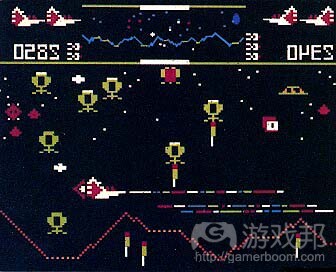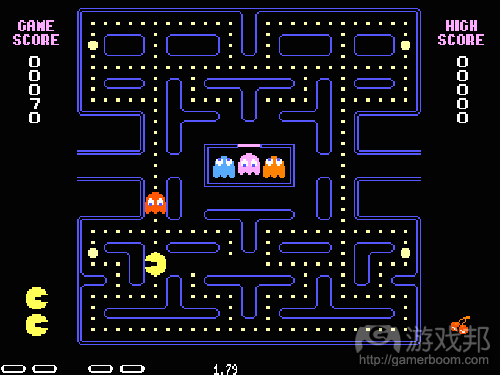阐述街机游戏与手机游戏设计的5个共性
任何看过我唠叨博文的人都知道今年我多么专注于阐述街机视频游戏的重要性。街机游戏设计师无法做出通过无数截屏和花哨动画来展现漫长故事的奢华之举,他们的任务是娱乐玩家并尽量赚取收入。后者或许正是为何街机游戏与现代手机游戏设计有如此高关联度的关键所在,这是游戏在短期内让人产生兴奋感带来的成果。
那么要如何实现这个目标呢?为何某些游戏更具吸引力,在玩家心目中有更高地位?我将在下文解析经典街机游戏设计技巧可用于现代手机游戏设计中的5个要素。我不是该领域的专家,但通过自己的观察也能总结出某些可能有助于手机游戏设计的建议。
1、吸引力
所有年龄足够大的玩家可能都还记得,在那个街机视频游戏繁荣的年代里,你满手紧握着硬币踏入店中时那些画面和音效带来的愉悦感。那种兴奋感让人不知所措,尤其当你面对大批新游戏之时。我清楚地记得当年那段时光,我踏进街机店中,用硬币来换取数分钟的兴奋之情。街机们仿佛都被赋予了生命力,间或与你交流以吸引注意力。每款游戏的模式都充满了吸引力,短暂的一瞥都可以感受得到。
某些较好的游戏光听声音就能辨别,音效使它们在众多同类游戏中显得鹤立鸡群。《Defender》中的上发条声,《小蜜蜂》中外星战机下落的音效,《抓间谍》中令人震惊的Peter Gunn声道。最吸引我的可能正是这些音效,或许我是最先用耳朵来判别游戏,随后才用上眼睛。
在某些情况下,街机本身也会产生吸引力。任何人都不会忘记装饰在《太空侵略者》街机边缘的6脚外星人。重点在于,街机首先必须吸引你的注意力。它必须让你走得更近些,才有机会让玩家明白游戏的内容。当你与街机只有一步之遥时,你最关心的可能就是控制。我非常肯定的是,自己绝不会仅仅为熟悉如何控制游戏而花钱。依我来看,街机游戏吸引玩家的做法值得借鉴。
在不断膨胀的应用商店中,你的游戏需要充满吸引力、可玩性、可控制性和娱乐性才能脱颖而出。你推销自己产品的时间并不多,应用商店中充斥着让人只有三分钟热度的游戏。
建议:将游戏所有场景都设计得很棒,甚至包括标题屏幕。
2、易用性
在生活中,无论我们做何种事情,都很可能逃避那些令人捉摸不透的东西。这是游戏设计师最关心的问题,也是最困扰街机游戏设计师的问题。除了《Defender》外,多数游戏的控制都简单易懂。确实,要让玩家只看一眼游戏控制系统就会马上明白游戏能够给自己带来乐趣。
早期的游戏只用1个操纵杆和1个按键。这种简单性至关重要,而且游戏设计师必须这么做。此类局限性在今天同样存在,尤其是在手持设备上,因为大量内容需要玩家控制来行动。后来有些游戏会提供简短的教程,告诉玩家如何控制游戏。这种做法很有效,但可能几乎没有玩家会看完教程的每个细节内容。街机游戏能给人来带来无尽乐趣的一大因素在于,你可以马上掌握控制方式,而且觉得这些控制都显得很自然。
控制只是要点之一,游戏如何开局也是关键。能否在刚开始便让玩家面临重重困境呢?这种开场会让玩家觉得没有丝毫机会,最有可能令他们感到愤怒。如果你在30秒的时间内迫使用户离开游戏,那么费尽心机来设计的大量游戏精妙场景都将成为无用之举。
建议:在玩家进入游戏时为其提供安全区。你用无数外星人来轰炸玩家之前,让他们有足够的时间冷静下来熟悉控制手法。在开始游戏前,我建议给玩家数秒时间移动和自由射击。
3、不断诱惑
利用你所有异乎寻常的游戏想法并将其制作出来,移除过时之物,让游戏吸引力达到最大化。比如,如果你有个绝妙的想法,玩家收集某些道具之后就能够升级,那么应当确保游戏不断提醒他们这是个需要去实现的目标。别让玩家遗忘你的所有精妙小想法。
有些最吸引人的街机游戏有个改变整个游戏的元素——力量升级。如果玩家获得了这个道具,就可以击败对手。《吃豆人》便运用了这种方法。所有人都知道,在游戏中吃到大型能量豆可以提升力量。这点很明显,而且也是玩家想做的事。即便身处危险境地之时,这仍然是玩家的目标。Pinky(游戏邦注:包括游戏中的其他怪物)总是在追捕你,但你清楚地知道只要能吃到那些能量豆,情况就会发生改变。这真是个相当不错的设计。
建议:不断向玩家提供能带来更大好处的小道具。别让他们忘记自己的目标。当所有小道具收集完成之后奖励玩家。必须时刻提醒玩家,小型额外奖励道具是值得获取的东西。
4、游戏内容简单明了
在任何游戏中,当某个角色出现在游戏画面中,它们与屏幕中其他事物视觉上的差异化都应让玩家马上理解他们需要做的事情。要让潜在玩家看下屏幕和控制就足以做出游戏中所有重要的行为。
玩家们都很懒惰,他们期望大部分脑力劳动由设计师来完成。对玩家而言,他们想做的只是了解控制方式后开始玩游戏。玩家需要游戏有缓冲时间,如果因首次尝试转向汽车而坠落悬崖,他们不希望就此看到游戏结束的画面。如果在前10秒游戏时间内,汽车通过首个弯道而不坠下悬崖,暗示玩家这是种相对安全的行动,但他们也应该做好掉落的准备。这将成为游戏的普遍特征,也是最简单的做法。
正如人们针对传统Atari(游戏邦注:某种家用游戏机)所说的那样:容易学习,难于精通。每款成功电子游戏的设计中都潜藏着这个要素,比如《愤怒的小鸟》。
让游戏内容简单明了的艺术就在于呈现方式上。大量外星战机在屏幕上方盘旋随即集结成队,屏幕底部显示一辆武装直升机,那么玩家很快就知道自己需要做什么。同样,如果你看到自己的武打角色直面模样类似的角色,可能也不会对自己下一步的行动感到困惑。正如之前提到的那样,让玩家熟悉游戏至关重要,这也是保持用户留存率的关键。
建议:在游戏美术设计中,显示玩家角色与其他游戏角色间的差别。当然也可以考虑优化动作场景,如果可以的话,区分玩家所处区域与对手所处区域的视觉效果。这种做法并不常见,但有时却非常有效。
5、为所有行为提供奖励
自己体验下游戏中的基本动作,包括移动、射击、跳跃等,让它们变得更为有趣。将动作夸张化,尽量提供音效和视觉效果反馈,奖励玩家的每个行动和成果。
我们仍以《Defender》为例。点击开火键,各色激光流纵贯屏幕之上,令人满意的电子激光音效,外星战机四分五裂,而且还有爆炸音效。别让玩家觉得自己做的是最没有价值的行动,为所有行为提供奖励!如果在敌机被击中时只呈现出橘黄色的火焰,这似乎是个很愚蠢的做法,但让玩家看到残骸四射,这却是个很大的奖励。游戏中的奖励不应局限于收集东西或完成挑战,应当延伸至玩家在游戏中做的所有事情。
虽然《毁灭战士》并非经典街机游戏,但用猎枪射杀Imp(游戏邦注:该游戏中的怪物)的过程值得参考。玩家瞄准目标并按下开火键,伴随着深层次的猎枪音效imp倒在血泊之中,猎枪重新填装子弹,而且还有音效。你可以进一步发展此类场景,比如开枪会惊醒附近的怪物。这本身就是种奖励,因为它带来新麻烦等待玩家去处理。所有这一切,玩家要做的只是按动开火键,真实精巧的游戏设计。
许多街机游戏都以各种形式来奖励玩家,但这些奖励都不如《太空侵略者》及其类似产品中射击和摧毁产生的即时满足感。
建议:尽量做出平台所能允许的“安全”视觉体验。如果玩家消灭屏幕上的东西,别简单地将其移除,应该摧毁。至少用单像素来呈现爆炸碎片。如果能在东西被摧毁时加上令人满意的相关音效,就更好了。玩家潜意识里会希望尽快再看到这些奖励,因为这是种让人有极大满足感的体验。
我希望自己的想法能够得到你的认同,或至少能让你产生某些想法。本篇文章的主题并不是“如何设计街机游戏”,而是我观察经典街机游戏所领悟到的内容。随着手机平台逐渐发展以及手机游戏的日益成熟,此类游戏与25至30年前街机游戏设计的共通点足以令人震惊。无论你设计何种游戏,最重要的是游戏必须充满乐趣。如果你自己都能够乐在其中,那么肯定会有相当多的用户认同这款游戏。(本文为游戏邦/gamerboom.com编译,如需转载请联系:游戏邦)
5 reasons why classic arcade games are relevant to mobile game design
Anyone who has read my blogged blitherings before will know how pre-occupied I am with the importance of the video game arcades of yesteryear. Arcade game designers did not have the luxury of being able to present protracted stories through endless cut-scenes and fancy cinematics. Their task was to entertain the player and take as many coins as possible. The latter is perhaps the key to why arcade games are so relevant to modern mobile game design since by definition it is an exercise in keeping game times short and thrilling.
So just how did they do it? Why were some games more appealing and revered amongst gamers as others? Here I offer 5 basic reasons why I think the lore of classic arcade game design is relevant to the design of modern mobile games. I’m by no means an expert but through my observations I’ve also managed to come up with what may be some useful tips on designing your own mobile games.
1. Attract
Anybody old enough to remember the heyday of the video game arcade will probably remember the sights and sounds that greeted you as you stepped in clutching your fistful of coins. It was giddying to say the least. Especially when faced with a selection of new cabinets. I remember fondly the times I spent treading the boards of the local arcade hunting for that one machine to which I would offer my coin in return for a few minutes of pure pixellated thrills. The cabinets had a life all of their own as they jostled, beeped, whined and occasionally spoke to you to attract your attention. Every game had it’s attract mode. That brief glimpse you got to view the game for free.
Some of the better games had an audible identity that set them aside from the all too generic laser bleeps of most. Defender’s electronic wind-up sound, Galaxians’ diving alien sound, Spy Hunter’s stunning Peter Gunn soundtrack… It was perhaps the effective use of sound that attracted me most. Perhaps I hunted with my ears far before I’d engaged my eyes.
In some cases it was about the cabinet itself. Who could forget the striking 6 foot alien that adorned the side of the Space Invaders cabinet? What’s important is that the game had to get you in. It had to pull you toward it such that you were close enough to see what it had to offer. By the time you’d got to within a foot of the cabinet you were probably more concerned with the controls than anything else. Just how damned hard is this thing going to be? I sure as hell don’t want to waste a coin on trying to figure out how to control the blessed thing! For me there is a valuable lesson to be learned here in attracting a player to your game.
In the ever-expanding app stores that we see for games on the web your title has to stand out as being attractive, playable, controllable and of course entertaining. You don’t get much time to sell your wares. The app stores are full of 3 minute thrills.
My tip: design your game to look good in ANY screenshot. Even the title screen.
2. Accessibility
In anything that we do in life we are most likely to shy away from anything that looks confusing. This is a huge concern for game designers and was a huge issue for arcade game designers. The spaghetti fingered controls of Defender aside most games kept it very straight forward. Indeed you could glance at a game’s control system and instantly know that you were going to enjoy playing the game.
Early games employed a single stick and a single button. This simplicity was vital and of course enforced on the designer. The same limitations apply today. Especially on hand-held devices where a certain amount of improvisation is required in terms of controlling the action. Later games with better capacity provided brief tutorials on how to control the game. Useful but probably rarely read through in any detail. A huge factor in enjoying an arcade game was being able to instantly pick up the controls and feel like it was all very natural.
But it’s not just about controls. Where do you start your game? Are you hurled straight in to chaos? Nothing is going to irritate a gamer more than standing absolutely no chance from the outset. All your hard work in designing the game’s numerous wonderful scenarios will be wasted if you turn your audience away within 30 seconds.
My tip: provide the player with a safe zone on entry. Before you unleash hell on him with countless dive-bombing aliens let him have a period of calm as he uses common sense to fiddle with the controls. In a shoot ‘em up, for example, I like to give the player a few seconds to move around and shoot at nothing before I introduce the cast.
3. Continually dangle the carrots
Take all your fantastic game ideas, implement them, play them, remove the duds and then concentrate it all down for maximum effect. If, for example, you have the wonderful idea of a power-up that the player receives for collecting certain items make sure that you constantly remind him that this is a goal to be achieved. Don’t let the player forget about all your wonderful little ideas.
Some of the most effective arcade games had that one game-changing element – the power-up. That single item that when collected gave you complete control over your adversaries. Pac-Man is the epitome of this. Everybody knows that eating the larger energy dot gives you the edge. It’s pretty obvious and is always in view. It’s something to aim for even though at times you find yourself in a sticky situation. You’re being chased by Pinky (or whichever one did all the chasing) but you know full well that if you could get to that larger dot the tables will be turned. Excellent design.
My tip: constantly drip feed the small bonus items that comprise a much larger benefit to the player. Don’t let them forget what they’re aiming for. When all smaller items are collected hit the player with his well earned benefit. Remind the player that bonuses really are worth aiming for.
4. Keep it obvious
Any game where a single character / avatar stands out by virtue of the fact that they are visibly different to everything else on screen is going to help the player understand what is required of them. A quick glimpse on screen and a quick glimpse down to the controls ought to be enough for a potential player to take that all important step up to your game.
Gamers are (or can be) very lazy. They expect much of the hard brain work to have been done by the designer. For the gamer it is all about picking up the controls and just getting on with it. Gamers want breaks. If they fall off the edge of the cliff with their first attempt at steering the car they don’t want to be told it’s GAME OVER. By virtue of the fact that the car COULD leave the cliff on the first bend within 10 seconds of game time ought to suggest to the player that this is a relatively safe action but something they should get very used to. It’s going to be a common feature in the game and not going to get any easier.
As the old Atari mantra used to read – simple to learn, hard to master. Every successful video game has this underlining its design. Modern classics such as Angry Birds epitomise it.
Much of the art of keeping things obvious is in the presentation. If you have a squadron of aliens hovering in formation above a solitary gunship at the base of the screen it’s pretty obvious what’s going to be expected of the player. Similarly if you see your kung-fu character standing directly opposite a similar looking character it’s pretty obvious what you’re in for. As mentioned previously helping the player to become familiar with your game is vital to it being adopted and enjoyed. It’s also key to it being played time and time again.
My tip: in your game’s artwork consider a visual separation between the player’s character / avatar and the rest of the game’s characters. Also consider the staging of the action. If possible visibly divide the screen up in to the player’s zone and the enemy’s zone. The latter is not always relevant but useful where possible.
5. Reward everything
Take your basic actions – movement, shooting, jumping, implement them and then play with them. Make them 10x more fun. Exaggerate them and provide as much audio / visual feedback as possible. Reward every action and every consequence in as flamboyant a manner as the platform allows.
Again I go back to Defender. Hit the fire button – stream of multi-coloured lasers thrash across the screen – satisfying electronic laser sound – alien explodes in to a million shards – satisfying explosion sound. Make it count that the player has just performed the most trivial of actions. Reward everything! It might seem silly to you to do nothing more than present a simple “puff” of orange when the enemy has been shot but the rewards to the player of seeing a shower of debris are enormous. Rewards in games are not limited to collecting things or completing challenges. Rewards extend to just about everything that a player is doing in a game.
It’s not a classic arcade game but consider the process of shooting an Imp with a shotgun in DOOM. Aim, hit fire button, deep gunshot sound, imp falls in shower of blood, visual reloading of shotgun with accompanying sound. You could take this scenario a step further by suggesting that the shotgun going off is actually a wake-up call to nearby monsters. This in itself is rewarding the player since it brings on a whole new level of chaos ready for the player to deal with. And all that the player had to do is press his fire button. Beautiful game design.
In the arcades there were many genres that lent themselves to rewarding the player in style. But none were as instantly satisfying as the shoot and destroy approach of Space Invaders and its clones.
My tip: create as much of a “safe” visual experience as the platform will allow. If you eliminate something from the screen don’t simply remove it – destroy it. Throw single pixels around at the very least. Better still accompany its removal with a satisfying and relevant sound effect. Subconsciously the player will seek to repeat this as quickly as possible since it is an enormously satisfying experience. But never force the player to have to handle the fallout of the action.
I hope that my thoughts meet with your own somewhere down the line. Or at least prompt some thoughts. If that is the case please feel free to share your comments. This article is not meant to be an “how to design an arcade game” more an insight in to the observations I have made whilst researching the classic games of the arcades. As mobile platforms evolve and their games mature it may be surprising just how relevant the design ethos of arcade games from 25 – 30 years ago are. Whatever game you design the most important thing is to have fun. If you’re enjoying it you can be pretty sure that there will be an appreciative audience somewhere. (Source: HTML5 Game Design)









































 闽公网安备35020302001549号
闽公网安备35020302001549号